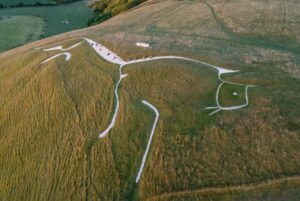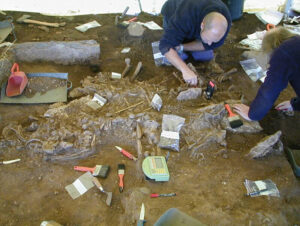Film, television, music, and literature have explored the legend of Atlantis, but what about the real sunken cities out there? Over the centuries, the ocean has swallowed up numerous towns because of climate change or natural disasters. Below, a metaphorical deep dive into seven of the world’s most iconic sunken cities.
Thonis-Heracleion, Egypt
In 1933, an RAF pilot flew over Abu Qir Bay near Alexandria and spotted something peculiar. Beneath the azure Mediterranean, he made out ancient ruins.
It was only years later that archaeologists excavated the ruins. In the 1990s and early 2000s, marine archaeologists discovered a whole city, Thonis-Heracleion. Once a bustling port, Thonis-Heracleion now lies five metres below sea level. The city dates back to the 12th century BC.
It featured a network of complex waterways, temples to Egyptian gods Amun-Gereb and Khonsu, storehouses, and other structures. Archaeologists found steles, statues, amulets made of gold, bronze, and lead, as well as lesser objects like bowls and tools. Many of these artifacts were well-preserved. In recent years, archaeologists have found two shipwrecks and another temple.

Ptolemaic coins found at the site. Photo: World Imaging
Most historians agree that Thonis-Heracleion sank into the sea because of a succession of natural disasters. Earthquakes and tsunamis resulted in gradual soil liquefaction, causing structures to sink into the sea over time.
Dwarka, India
Dwarka, the god Krishna’s earthly home, is one of the four holiest Hindu sites. Hindus believe that it dates back 10,000 years. Legend says that after Krishna died, his beloved city and its occupants sank into oblivion.
Hindu sources describe Dwarka’s unparalleled beauty and extravagance: palaces of precious metals, stones, and jewels. Apart from its mythical statues, Dwarka held great importance as a trading port and a vital trading gateway to the Arabian Sea.

Dwarka in Gujarat, India. More of the ancient city is submerged. Photo: Imagine Rural/Shutterstock
Archaeologists began searching for the city in the mid-20th century, yet it wasn’t until the 1980s that they unearthed some promising ruins. Excavations revealed pillars, walls, pottery, streets, and anchors.
Possible causes for the city’s demise include an earthquake, tsunami, or climate change.
Shicheng, China
In 1959, the Chinese government decided to create an artificial lake as part of a major hydroelectric development project. The drawback? They had to submerge an ancient city dating back to 25 AD.
The decision was contentious. Critics decried the displacement of 300,000 residents from the area and the flooding of a priceless historical site. Others have hailed the decision because it created one of the world’s most magnificent diving sites, the “Atlantis of the East”.

Intricate designs on the city walls. Photo: Nihaopaul
Shicheng, or Lion City, was one of Imperial China’s main commercial centres. It peaked in the 16th century as a cultural, economic, and political hub. You can see its power and wealth in the grand, highly detailed arches, walls, gates, and statues depicting Chinese mythology. The city is extremely well-preserved, thanks to stable temperatures 40m underwater.
It was not until the 21st century that China allowed divers to explore the city.
Atlit Yam, Israel
In Israel, 12m below sea level, lies a 9,000-year-old Neolithic village. It is the world’s oldest submerged site and contains one of the oldest cases of tuberculosis on record.

Atlit Yam stone circle in Israel. Photo: Hanay
Archaeologist Ehud Galili discovered the village in the 1980s. Researchers subsequently found 65 human remains in graves, houses, tools, and seven megaliths forming half a circle. They also found remnants of plants, animal bones, and burial goods.
But it is evidence of bovine tuberculosis that remains the most startling discovery to date. Scientists found the disease in the skeletal remains of a mother and baby. This outbreak was probably the result of animal domestication and husbandry practices.
According to Italian researcher Maria Pareschi, a possible volcanic eruption in Italy and the resulting tsunami might have been responsible for the city’s destruction. However, others believe that rising sea levels could be the culprit.
Saeftinghe, Netherlands
The Westerschelde Estuary in the Netherlands is a large nature reserve and marshland, full of plant and bird life. Long before twitchers and wildlife photographers flocked here, this swampy area hosted a thriving village that met a murky end in the 16th century.
In the 1200s, the area was already water-logged and marshy, so monks from a nearby abbey drained the land to prepare the soil for agriculture. They were successful and a few centuries later, the village of Saeftinghe enjoyed rich harvests.
During the Eighty Years’ War — when the Netherlands fought for independence from Spain — armies often breached the village walls, and the village suffered bad flooding. The most famous and catastrophic of these was the All Saint’s Flood of 1570. Faced with these disasters, the residents left.
According to legend, the village’s bad luck was the result of a merman’s curse. The merman denounced the village for its cruelty and decadence, resulting in the All Saint’s Flood.
Today, it is now called the Drowned Land of Saeftinghe. It is the largest tidal marshland in the Netherlands, encompassing 36 sq km of tidal land. Hundreds of bird species breed here, and Saeftinghe is now a nature reserve.
The village itself, which included a castle, an abbey, a tollhouse, and ordinary houses, remains submerged in the wet mud somewhere. None have turned up yet, although archaeologists have found several small artifacts over the years.

An aerial view of the Saeftinghe marshes. Photo: Rudmer Zwerver/Shutterstock
Port Royal, Jamaica
The famous town from “Pirates of the Caribbean”, where Jack Sparrow caused havoc, was not entirely fictional. During the 17th century, Port Royal became one of the Caribbean’s most important cities, a center of trade and commerce. Unfortunately, it also gained a reputation for immorality and piracy.

A painting of Port Royal. Painting: James Hakewill (1875)
In June 1692, it seemed like the wrath of God had descended on the town. A 7.5 magnitude earthquake shook the island and obliterated Port Royal, killing over 5,000 people. Those who survived reported that two-thirds of the city slid into the sea. After the earthquake, a tsunami and a major landslide from (ironically) Judgement Hill made matters worse.
Port Royal sank so quickly into the sea because it sat on loose sediment rather than a foundation of bedrock. These poor foundations prevented any plans to rebuild the city.
In 1981, excavations by the Texas A&M University found the well-preserved ruins. In order to scuba dive here, you need a special permit. While the old settlement lies beneath the waves, a fishing village also called Port Royal now sits on dry land nearby. Organizations on the surface have been advocating for the original town’s reconstruction and resurrection.
The lost villages of Ontario
The completion of Canada’s St Lawrence Seaway in 1959 granted access to the Great Lakes from the Atlantic. A major achievement, but at the cost of 10 submerged villages — Woodlands, Santa Cruz, Wales, Aultsville, Dickinson’s Landing, Maple Grove, Mille Roches, Moulinette, Farran’s Point, and Sheek’s Island. Collectively, they are now known as the lost villages of Ontario.

The lost villages of Ontario, an aerial view. Photo: Louis Helbig
Residents were relocated but they felt ripped off, both financially and culturally. The residents had to give up their family homes and move their businesses. Dating back to the 18th century, the historic villages are nowadays a mecca for divers. They explore old buildings, homes, yards, some still-standing fences, old warships, and boats.






